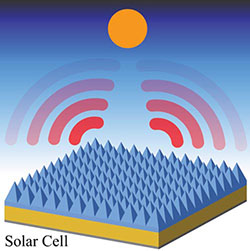
A patterned silica overlay reflects unwanted thermal radiation. Credit: Optica
For solar cells to operate efficiently there needs to be a low-cost, low-energy way to keep them cool—a difficult task for a device exposed to the hot sun. A team of researchers from Stanford University, U.S.A., describe a method of passively cooling solar cells with a patterned overlay of silica glass in OSA’s new journal Optica (DOI: 10.1364/OPTICA.1.000032).
Solar cells are readily available and easy to manufacture, but even the best designs convert only 30 percent of the energy they collect from the sun into electricity. The rest is lost—mainly to overheating from infrared thermal radiation. Excess heat also shortens the life span of the cells. After testing several designs, the Stanford team, led by Shanhui Fan, found that a thin layer of silica embedded with a pattern of pyramids and cones allows visible light to enter the cell and be converted into electricity, while reflecting the damaging infrared radiation.
Even in average environments, solar cells can reach temperatures of 55°C. For every one-degree increase, the cell efficiency decreases about one-half a percent; for every eight-degree increase, the cell aging rate doubles. Cooling the cells with a ventilation system or chemicals would cost extra money and energy, negating their benefit. Therefore, the low-cost patterned silica overlay could, as lead author Linxiao Zhu predicts, “address an important technological problem in the operation and optimization of solar cells.” The researchers are planning to test the radiative cooling effects of their silica film in an outdoor environment.
